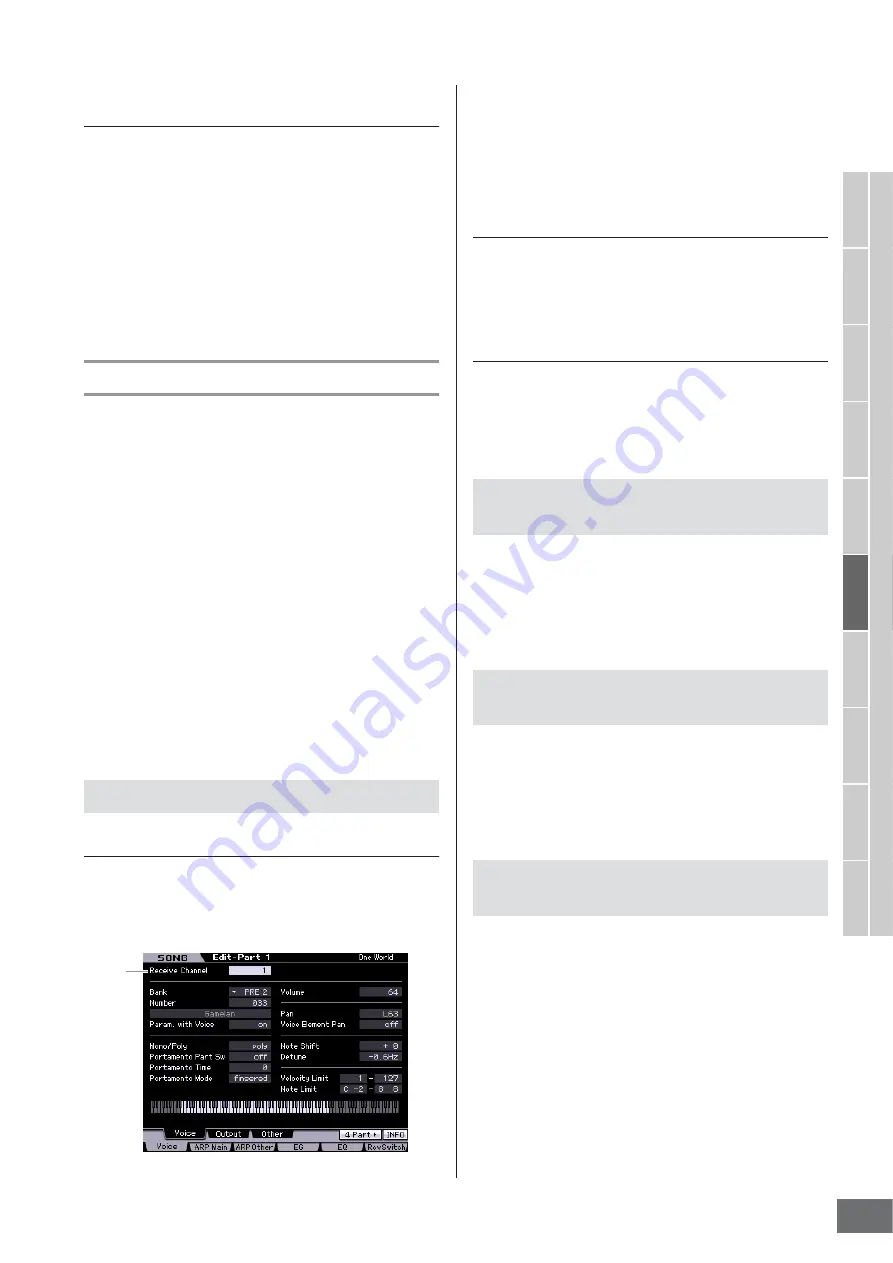
Multi-timbral Tone Generator Settings for Song/Pattern Playback (Mixing mode)
MOTIF XS Owner’s Manual
235
V
oice mode
Song mode
P
attern mode
Mixing mode
Master mode
Utility mode
File mode
P
erf
ormance
mode
Sampling
mode 1
Sampling
mode 2
Ref
erence
[SF3] Reverb
[SF4] Chorus
From the Type column on these displays, you can select the
Reverb/Chorus type. From the Preset column, you can select
one of the templates that call up the pre-programmed settings
of various parameters of the selected Reverb/Chorus type.
From these displays, you can also set each parameter of the
selected Effect type individually and manually.
The function of these displays is the same as those of the
Reverb display and Chorus display (page 150) in the
Performance Common Edit mode.
Part Edit parameters
[SONG]/[PATTERN]
➞
[MIXING]
➞
[EDIT]
➞
[1] – [16] Part selection
In the Part Edit mode, you can edit the parameters of the
individual Parts such as Voice, Arpeggio, EG and EQ settings.
Selected Part display/Four-Part display
Just as with the Performance Part Edit mode, you can use two
types of display in the Mixing Part Edit mode. One type of
display lets you edit parameters for the currently selected Part
and the other type of display lets you view parameters for four
Parts. You can switch between these two types by pressing the
[SF5] button. Note that the display for four Parts is not available
for the [F2] ARP Main and the [F3] ARP Other displays.
Selecting a Part to be edited
Press one of the [1] – [16] buttons to select a Part to be edited.
n
For details about useful functions such as Mute and Solo, see
page 233.
[SF1] Voice
This display lets you specify the MIDI receive channel for the
current Part as well as the Voice. The other parameters except
for Receive Channel (
1
) are the same as those in the Voice
display (page 151) in the Performance Part Edit mode.
1
Receive Channel
Determines the MIDI receive channel for the selected Part.
Since MIDI data may be coming from many channels at
once, you should set this to match the particular channel
over which the desired controlling data is being sent
Settings:
01 – 16, off
[SF2] Output
From this display, you can set the Reverb/Chorus depth
and the Output jack assignment for each Part. The function
of this display is the same as the one in the Output display
(page 152) in the Performance Part Edit mode.
[SF3] Other
From this display, you can set parameters related to pitch
bend and velocity. The function of this display is the same
as the one in the Other display (page 153) in the
Performance Part Edit mode.
This display determines the basic settings of the Arpeggio.
The settings of parameters shown at the bottom of the
display can be registered to the [SF1] – [SF5] buttons.
The function is the same as the one in the Arpeggio Main
display (page 154) in the Performance Part Edit mode.
By changing the timing and velocity of the notes, you can
change the rhythmic “feel” of the Arpeggio playback.
The function of this display is the same as the one in the
Arpeggio Other display (page 156) in the Performance
Part Edit mode.
These settings let you control the sound transition from the
moment a key is pressed to the moment at which it is
released. You can also adjust the tone brilliance by setting
the Cutoff Frequency and Resonance.
The function of this display is the same as the one in the
EG display page 157) in the Performance Part Edit mode.
Part Basic Settings—[F1] Voice
1
Arpeggio Basic Settings—[F2] ARP
Main (Arpeggio Main)
Changing rhythmic feel of the Arpeggio—
[F3] ARP Other (Arpeggio Other)
EG Settings—[F4] EG (Envelope
Generator)
Summary of Contents for MOTIF XS6
Page 1: ......






























